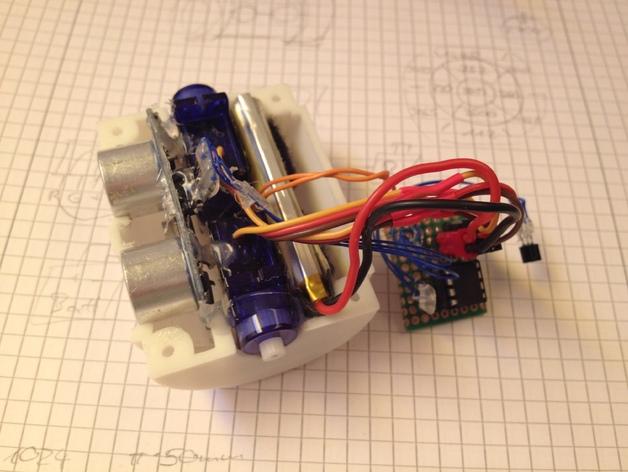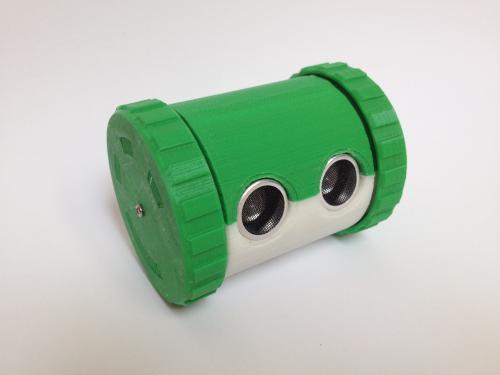It doesn’t promise to taste great or to be less filling, but Attiny Canbot sure is cute.
This project springs from the mind of Thingiverse contributor Maxmillian Kern, who goes by the pseudonym ‘Wingman94.’ In a nutshell (or in a can) the creature is a cylindrical robot that rolls its way across surfaces at the instruction of an Atmel Attiny85 microcontroller.  The commands are received via an infrared signal sent from a modified remote control for television. For those who would like a more hands-off approach to Canbot husbandry, the critter is equipped with an ultrasonic sensor for autonomous driving. This means you can give Canbot freedom to roam about your house and he won’t spend 20 minutes blindly butting himself into a wall.
The commands are received via an infrared signal sent from a modified remote control for television. For those who would like a more hands-off approach to Canbot husbandry, the critter is equipped with an ultrasonic sensor for autonomous driving. This means you can give Canbot freedom to roam about your house and he won’t spend 20 minutes blindly butting himself into a wall.
Kern’s Canbot is a descendant of another diminutive mechanical dynamo he created two years ago, a bipedal robot with a face only its programmer could love. Recouping on the effort put into programming the Walking Wired, he recycled some of the code he had used and thus was born child-of-biped Tiny Canbot. While drawing on inspiration from the iPhone controlled Ollie Robot for the form, the design of the Canbot is sleeker and less kitsch.
In an interview with 3DPrint.com, Kern explained how he developed the robot:
“The design is functional. I basically just arranged the parts in CAD to find out what shape fits best. There are two printed half shells that hold the servos, battery, ultrasonic sensor and electronics. They are connected by four screws. Two printed wheels are screwed onto the servos heads. I used PTC Creo to model the parts, Slic3r for slicing and a Prusa i3 Hephestos from BQ to print them. The prints took about 3 hours for each shell and half an hour or so for each wheel.”
Not one to gloss over imperfections, Kern acknowledges that there are problems with the weight distribution in his cylindrical progeny. However, he has made a conscious choice not to engage in body shaming his offspring and doesn’t plan to make drastic changes because the robot is still fully functional.
In the spirit of sharing, Kern has released the files for the minuscule marauder on Thingiverse so that others can create their own army of rolling creations – technically known as a ‘fluffle,’ I believe. Given that each creature takes between 8 and 10 hours to print, if you start now, you could probably be ready to take a few out partying this weekend. I’ve heard that’s what all the cool kids are doing.
Let us know if you gather your own rolling robot group together in the 3D Printed Attiny Canbot forum thread over at 3DPB.com.
Subscribe to Our Email Newsletter
Stay up-to-date on all the latest news from the 3D printing industry and receive information and offers from third party vendors.
You May Also Like
Precision at the Microscale: UK Researchers Advance Medical Devices with BMF’s 3D Printing Tech
University of Nottingham researchers are using Boston Micro Fabrication‘s (BMF) 3D printing technology to develop medical devices that improve compatibility with human tissue. Funded by a UK grant, this project...
3D Printing Webinar and Event Roundup: April 21, 2024
It’s another busy week of webinars and events, starting with Hannover Messe in Germany and continuing with Metalcasting Congress, Chinaplas, TechBlick’s Innovation Festival, and more. Stratasys continues its advanced training...
3D Printing Webinar and Event Roundup: March 17, 2024
It’s another busy week of webinars and events, including SALMED 2024 and AM Forum in Berlin. Stratasys continues its in-person training and is offering two webinars, ASTM is holding a...
3D Printed Micro Antenna is 15% Smaller and 6X Lighter
Horizon Microtechnologies has achieved success in creating a high-frequency D-Band horn antenna through micro 3D printing. However, this achievement did not rely solely on 3D printing; it involved a combination...





























